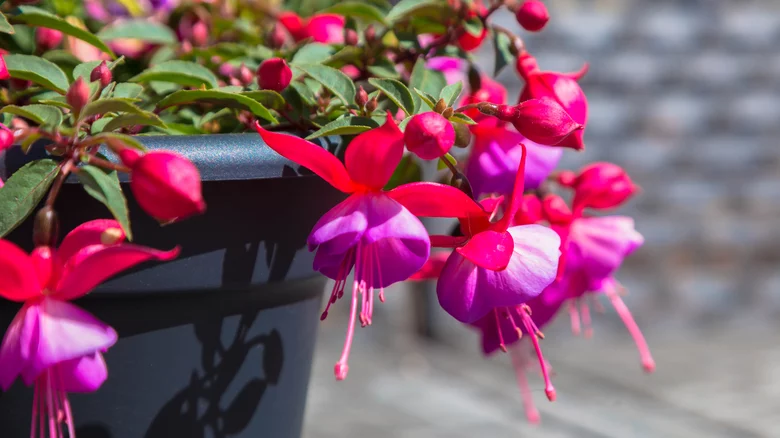
Fuchsia plants (Fuchsia triphylla) are a favorite for gardeners due to their vibrant, bell-shaped flowers and adaptability. Whether in hanging baskets, containers, or flowerbeds, they can enhance your outdoor and indoor spaces. Here’s how to grow, care for, and propagate fuchsias effectively.
1. Planting Fuchsia
- Location: Choose a spot with filtered sunlight or partial shade. Avoid direct afternoon sun to prevent scorching.
- Soil: Use well-draining potting soil enriched with organic matter for optimal growth.
- Planting Time: Late May to early June is ideal for most varieties.
- Container Gardening: If planting in pots, ensure they have adequate drainage holes. Miniature fuchsias work well for small containers, while climbing varieties thrive in larger ones.
2. Light and Watering Requirements
- Light: Provide bright, indirect light. Too much direct sun can harm the plant, but insufficient light may reduce blooming.
- Watering: Keep the soil moist but not soggy. Overwatering can lead to root rot, so ensure the pot drains excess water.
- Humidity: Fuchsias thrive in humid conditions. Consider misting the plant or placing it in a naturally humid area.
3. Fertilizing
- During the blooming season, use a balanced liquid fertilizer every two weeks.
- Enrich the soil with organic compost for sustained nutrient release.
4. Pruning and Deadheading
- Deadheading: Pinch back spent flowers immediately to encourage continuous blooming.
- Pruning: Trim stems and shoots to promote bushier growth and better air circulation. Remove dead or diseased leaves and stems regularly.
5. Propagation
- Best done in spring, but summer and fall are also suitable.
- Steps:
- Cut stems just below the third leaf node.
- Dip the cuttings in rooting hormone (optional).
- Plant them in moist potting soil and cover with a plastic bag to maintain humidity.
- Keep in a warm, bright area until roots develop.
- Transplant cuttings into individual pots once they establish roots.
6. Common Issues and Solutions
- Root Rot: Prevent by using well-draining soil and pots with drainage holes.
- Pests and Diseases: Inspect for fungal infections, aphids, or whiteflies. Treat with neem oil or insecticidal soap as needed.
- Wilting Leaves: This could indicate overwatering, underwatering, or excessive direct sunlight.
7. Overwintering Fuchsias
- In colder climates, fuchsias can be overwintered indoors:
- Cut back the plant to a few inches.
- Store in a dark, dry area with minimal watering (just enough to keep the soil from drying out completely).
- Reintroduce to sunlight and warmth in spring.
8. Popular Fuchsia Varieties
- Fuchsia “Dollar Princess”: Hardy with vibrant red and purple flowers.
- Fuchsia “Swingtime”: Ideal for hanging baskets, with red sepals and white petals.
- Fuchsia “Seventh Heaven”: A lavish trailing variety with pink and white flowers.
- Fuchsia “Lady in Black”: A climbing variety that can grow up to 6.5 feet in a season.
9. Repotting Fuchsias
- Repot annually or when the plant outgrows its container.
- Use a pot 1-2 inches larger than the previous one.
- Place a plastic screen or coffee filter over drainage holes to prevent soil loss.
- Fill the pot halfway with soil, position the plant, and add soil and mulch to stabilize it.
10. Edible and Non-Toxic Benefits
- Safe for Pets: Fuchsia is non-toxic to cats, dogs, and horses.
- Culinary Use: The berries can be used in jams, and flowers can be added to salads or used as garnishes.
Key Takeaways
- Provide the right balance of light, moisture, and nutrients.
- Prune and deadhead regularly to promote continuous blooming.
- Propagate easily with cuttings for more plants at no extra cost.
- Overwinter indoors in colder climates to preserve the plant for the next season.
With proper care, fuchsia plants can thrive and bring vibrant beauty to your garden or home year-round! 🌺
